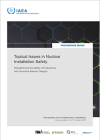The protection of people and the environment in countries with nuclear installations relies on the existence of a solid regulatory framework that oversees the safety of these installations. The IAEA promotes and supports the establishment of comprehensive regulatory frameworks to ensure the safety of nuclear installations throughout their lifetime.
Nuclear installations
These regulatory frameworks consist of relevant legislation, regulations and guidance and a robust leadership and management programme for safety. It is essential to ensure that an operational and effectively independent regulatory body is established and maintained for the regulatory control of nuclear installations. This body needs sufficient resources and suitably qualified and competent staff that are enabled to fulfil their regulatory responsibilities and functions.
The IAEA’s Safety Standards and the Code of Conduct on the Safety of Research Reactors lay out the international requirements and recommendations for enhancing existing or developing regulatory systems for the control of nuclear installations throughout their lifetime until they are released from regulatory control, and any subsequent period of institutional control. The Convention on Nuclear Safety also provides to its contracting parties a set of obligations, including those relative to their legislative and regulatory framework and regulatory bodies.
Providing services and tools for regulatory bodies
The IAEA offers the Integrated Regulatory Review Service (IRRS) to Member States, which is specifically designed to strengthen and enhance the effectiveness of the national regulatory infrastructure of countries operating or embarking on the construction of nuclear installations. It compares these countries’ regulatory safety infrastructure against the requirements and recommendations of the relevant IAEA Safety Standards and, where appropriate, good practices elsewhere. The IAEA provides technical advice and expert support to upgrade Member States’ regulatory infrastructures through capacity-building activities and expert missions.
The IAEA has developed a number of tools and methodologies to assist regulatory bodies of nuclear installations in strengthening the effectiveness of their functions and processes, as well as to facilitate the organization and efficient conduct of IRRS missions. These include:
- The Self-Assessment of Regulatory Infrastructure for Safety (SARIS), a methodology and set of tools to facilitate Member States' own assessment of the regulatory framework for safety with respect to the IAEA Safety Standards;
- The Integrated Review of Infrastructure for Safety (IRIS), a methodology and tool to assist Member States in undertaking self-assessments when embarking on a nuclear power programme, based on the relevant IAEA Safety Standards;
- The IAEA-developed Systematic Assessment of Regulatory Competence Needs (SARCoN) methodology and software tool support Member States’ work to ensure regulatory competence in line with the IAEA safety standards; and
- The International Regulatory Framework (RegNet), a web-based portal that supports national and international stakeholders in sharing their regulatory knowledge, practices and information and in fostering collaboration through networks and forums of regulators. These networks and forums currently include the IRRS RegNet Portal, which is a platform designed for sharing information among regulators on the preparation, conduct and assessment of IRRS missions; the Regulatory Cooperation Forum (RCF), a regulator-to-regulator forum that promotes the sharing of regulatory knowledge and experience; the Regulatory Competence Management (RCM), a forum to foster strategic approach to education and training in nuclear safety; the Embarking Countries on Nuclear Power Programmes, a forum that facilitates the sharing of experience of countries embarking on nuclear power; and the Small Modular Reactors (SMR) Regulators’ Forum, focused on investigating effective regulatory approaches for these type of reactors.








